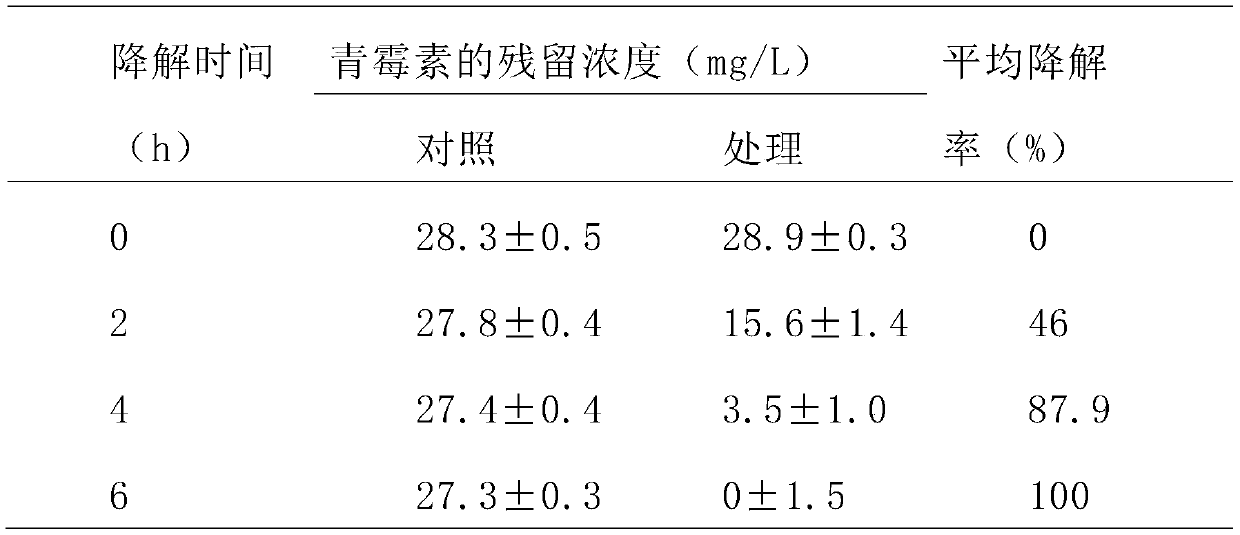Phagocytosis capable of degrading penicillin, cell fractions and compositions thereof
A technology of phagocytosis and penicillin, applied in the field of phagocytosis, cell fractions and their compositions, can solve the problems of secondary pollution, high energy consumption, unpleasant exhaust gas, etc., and achieve the effect of energy saving and cost saving
- Summary
- Abstract
- Description
- Claims
- Application Information
AI Technical Summary
Problems solved by technology
Method used
Image
Examples
Embodiment 1
[0029] Example 1: Screening, identification, degradation ability and sequence determination of phage strains
[0030] Step 1: Collect 10 g of sludge from the surrounding area of an antibiotic enterprise, inoculate it into 100 mL of inorganic salt medium containing 30 mg of penicillin, and culture it on a shaker at 30°C and 160 rpm. Transfer once every 7 days after the start of culture, and transfer to a higher concentration of penicillin-containing medium with a 10% (V / V) inoculum during transfer. The concentration of penicillin is 10mg / L, 30mg / L, 60mg / L, 90mg / L, 120mg / L, and so on, to 900mg / L, to obtain different concentrations of enriched culture solution containing bacteria.
[0031] Wherein, the composition and the proportioning ratio of the inorganic salt culture medium among the present invention are (g / L): K 2 HPO 4 1.6g, KH 2 PO 4 0.4g, MgSO 4 ·7H 2 O 0.2g, CaCl 2 2H 2 O 0.025g, FeCl 3 ·6H 2 O 0.0023g, NH 4 NO 3 0.5g, 20.0g agar, adjust the pH value to...
Embodiment 2
[0042] Example 2: Screening and identification of phage strains and determination of their degradation ability to penicillin
[0043] Step 1: Take 10g of sludge and put it in a sterilized 250mL Erlenmeyer flask, add 100mL of penicillin solution with a concentration of 0.3g / L, and culture on a shaker at 30°C with a rotation speed of 160r / min. After the culture starts, transfer once every 7 days, inoculate into fresh penicillin solution acclimation medium with 10% (V / V) inoculum amount during transfer, and gradually increase the content of penicillin. Detect the degradation rate of penicillin, and select the best group for the isolation of strains.
[0044] Step 2: the bacterial suspension (1 × 10 7 cells / mL) were inserted into 100 mL of tap water containing 30 mg / L penicillin, three parallels were taken, and tap water containing the same concentration of penicillin without inoculating bacteria was used as a control. Cultivate on a shaker at 30° C. and 160 rpm for 2, 4, and 6 ...
Embodiment 3
[0049] Example 3: Screening of phagocytosis bacteria strains and determination of penicillin degradation ability in bacteria residue
[0050] Pass the penicillin waste wet mycelium through a 0.2mm sieve, weigh 10g of the sieved waste mycelium, put it into 100mL of tap water, and add the penicillin waste hyphae obtained after cultivating for 48 hours to the waste wet mycelia solution at about 30°C. Phage 6g (wet weight), 3 groups of parallel experiments were set up, taking the addition of penicillin mycelium but not adding phage phage as a control, taking samples for 0, 2, 4, and 6 hours respectively, and detecting penicillin in the mycelium by HPLC residual amount. The results show that the degradation rate of penicillin can reach 100% after the interaction between phage phage and penicillin hyphae at 30°C for 6 hours.
[0051] Table two KDSPL-04 bacterial strains to the degradation effect of penicillin in the bacteria residue
[0052]
[0053] The beneficial effects of t...
PUM
 Login to View More
Login to View More Abstract
Description
Claims
Application Information
 Login to View More
Login to View More - R&D
- Intellectual Property
- Life Sciences
- Materials
- Tech Scout
- Unparalleled Data Quality
- Higher Quality Content
- 60% Fewer Hallucinations
Browse by: Latest US Patents, China's latest patents, Technical Efficacy Thesaurus, Application Domain, Technology Topic, Popular Technical Reports.
© 2025 PatSnap. All rights reserved.Legal|Privacy policy|Modern Slavery Act Transparency Statement|Sitemap|About US| Contact US: help@patsnap.com



